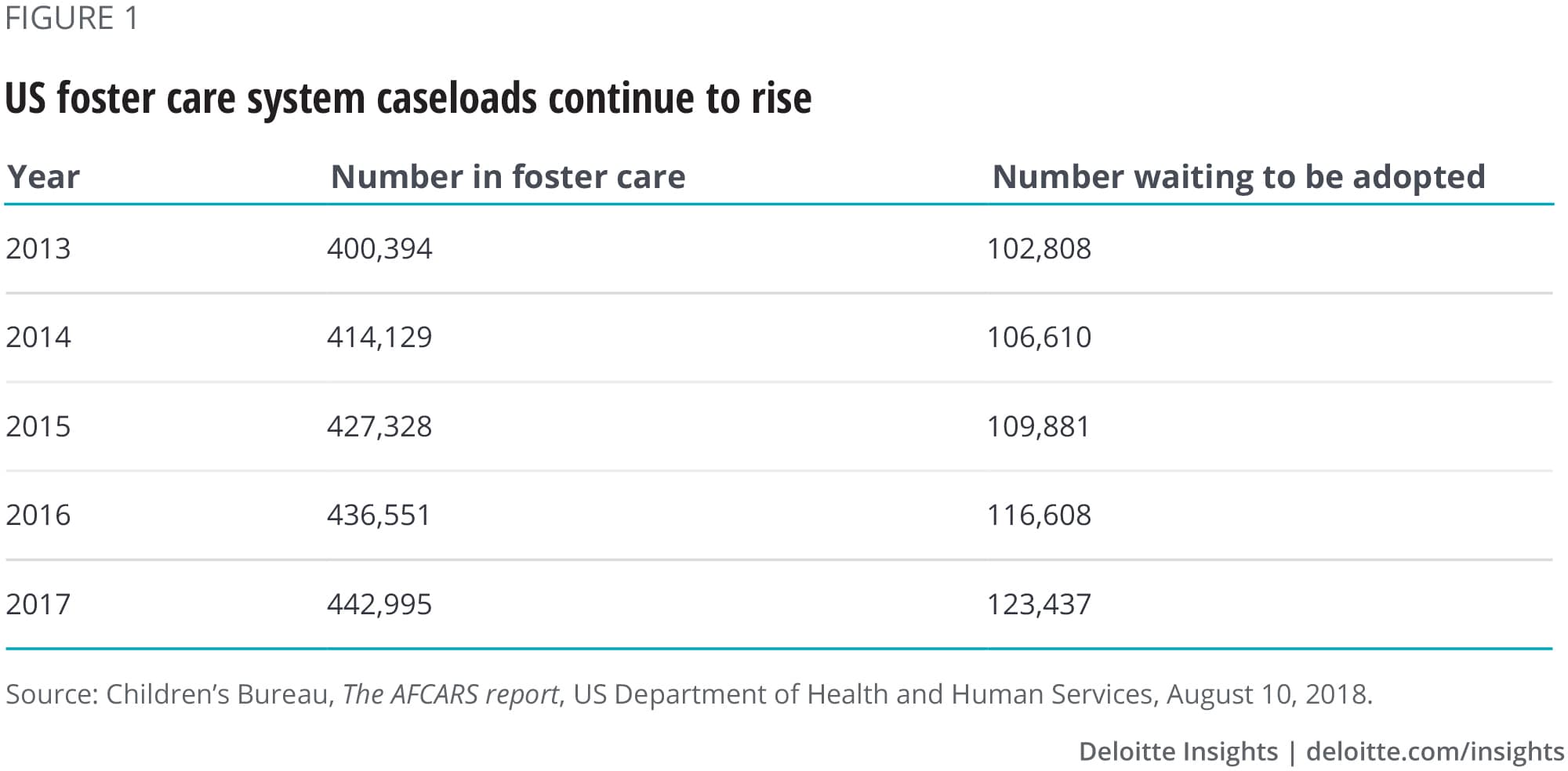
The case for a youth portal Supporting adolescents on the way to adulthood
6 minute read
06 December 2019
Adolescents in foster care often face a bleak future. A robust information portal can help make their transition to adulthood more successful.
Across the United States, foster care caseloads continue to rise. At last count, there were nearly 443,000 children and youth in the US foster care system, with more than 123,000 waiting for adoption (figure 1). Of those awaiting adoption, nearly 10 percent (13,451) are in the age range of 15–17.1 These teenagers are adopted at a lower rate than younger children, wait longer to be adopted, and are more likely to age out of the system without a stable place to call home, all of which may adversely impact their life trajectories upon emancipation.

Learn more
Explore the HHS Innovator's Playbook
Dive into the Government and public services collection
Subscribe to receive related content from Deloitte Insights
Download the Deloitte Insights and Dow Jones app
Without the benefit of a stable, supportive home, young people who age out of foster care face a bleak future. According to iFoster, within four years of aging out of foster care:
- Seventy percent will be on government assistance
- Half will be unemployed
- Half will experience homelessness
- A quarter will not have completed high school
- Fewer than 12 percent will earn a college degree2
The result is a “US$1 million economic burden to society for each young person we fail.”3
While the vast majority of states have extended eligibility for foster care to age 21, the reality is many young people still opt to leave the system when they turn 18.4 If states can’t convince them to stay, the question becomes, how do they best equip them with the support they need to transition successfully?
In this article, we lay out our vision for a robust youth portal to support youth currently in care, those transitioning, and those who have exited the system. The goal is to support these adolescents during a critical period on the road to adulthood.
Reimagining supports for adolescents transitioning to adulthood
Turning 18 marks an important rite of passage into adulthood. For youth outside the foster care system, that passage almost always comes equipped with a lifeline back to a parent or relative who continues to play an important role long after they have left the nest. It’s not unusual for parents or relatives to continue to perform various functions to ease the transition to adulthood, including:
- Storing important documents and records
- Transferring tacit knowledge and guidance to navigate adulthood
- Providing moral support through life’s ups and downs
Foster youth need and deserve these same supports.
Federal legislation mandates transition planning, and many states have made it easier for youth who are approaching emancipation to access resources, consolidating those links in a single place. But vulnerable youth need more robust support to help them overcome the significant disadvantage from which they start their journey to adulthood.
A robust youth portal for a foster care system should change lives for the better. Such a portal would:
- Provide information in a style that is digestible, dynamic, and easy to use
- Be relevant and focused on issues facing youth
- Provide engaging material that attracts youth to visit
- Provide functionality that supports their needs
Here we examine the breadth of functionality and ease of use such a portal could include.
Virtual safe for important records
Before emancipation, states are required to furnish foster care youth with copies of their birth certificates, Social Security cards, health insurance information, medical records, and driver’s licenses or state-issued IDs. The American Bar Association recommends that youth aging out of foster care should receive much more, including a full accounting of their past, plus the documentation they would need if they wished to reenter care, access their case files, apply for financial aid, and so on. Those documents would include:
- Credit report
- Proof of citizenship or legal residency
- Letter including the dates that they were within jurisdiction of the court
- Letter including a statement that they were in foster care, in compliance with financial aid documentation requirements
- Educational records
- Documentation of a health power of attorney
- Clear and age-appropriate written instructions on filing a petition to reenter care, including a completed sample petition
- The process for accessing their case file
- Death certificates for their parents (where applicable)
- Termination of parental rights orders (where applicable)5
Given the well-documented housing challenges that youth contend with when they age out of foster care, a virtual safe for storing these documents would be a tremendous help. A youth portal would, among other things, provide a repository that youth could access while they’re in care, in transition, or after they have exited. The virtual safe would also provide an audit trail of the time a young person has spent as a ward of the state, including their placements and relevant contact information. This information would let youth reach back out to caseworkers, adults, and mentors with whom they formed connections and meaningful relationships during their years in care.
Actuating transition plans
The Fostering Connections Act requires transition plans for youth exiting foster care. Ninety days before their 18th birthday, a young person is to sit down with his or her caseworker and designated representative(s) to map out a transition plan. Among other things, this plan addresses housing, education, employment, mentoring, and continued support services.
This static plan could be made far more dynamic and actionable with:
- A tailored list of resources and supports that map to the transition plan
- Behavioral nudges to prompt specific actions by youth and caseworkers
- Alerts to tell the young person, for example, about openings for suitable housing and jobs
- A tool for tracking progress against the young person’s own goals and aspirations
A well-conceived youth portal would bring transition plans to life for digital natives. It would animate a plan by breaking it down into a set of discrete actions, along a timeline, with prompts to take action and engage with relevant resources that can further the young person’s goals.
Youth in foster care could start using the portal at around age 14, well before they are ready to plan for emancipation. At that point, the portal would offer age-appropriate modules in areas such as financial literacy and money management. It could provide supports for tutoring, mentoring, and college prep, and provide strength and aptitude testing paired with targeted job placement, helping youth to start building their résumés and think about future careers. It could also provide mental health modules to help them understand the trauma that brought them to child welfare in the first place and connect them to appropriate counseling resources.
These functions would introduce younger teens to the youth portal, getting them accustomed to using it long before they start planning their transitions. It would serve as a pseudo “nagging parent,” getting young people started on activities they should be doing at various stages of adolescence, to ease the transition to adulthood and set themselves up for greater success.
Posttransition, the portal could continue to guide young people through the ordinary tasks of adulthood. It could prompt them to take actions such as making annual doctor’s appointments, scheduling routine dental care, attending counseling sessions, preparing and filing taxes, monitoring their credit rating, staying up to date on vehicle and voter registrations, creating a budget, saving for retirement, and accessing relevant benefits.
Fostering relationship development
Too many youths exit foster care with underdeveloped relationship-building skills. But we know that the ability to develop lifelong connections and build meaningful relationships is critical for success.
A robust youth portal would help to assess the ability to forge and sustain new relationships. It would also connect youth leaving foster care with mentorship programs within their community, to help them develop meaningful relationships with adults outside the system, as well as with peers who have been in their shoes and successfully navigated life after foster care.
This type of matchmaking is already starting to emerge in the child welfare arena. Take Colorado’s “I’m into” app, for example. The idea for this app emerged after the state’s youth development plan identified a need to better connect at-risk youth with organizations in the state that can help them. Currently in development, the app aims to engage youth in the process of self-discovery, both to increase self-awareness and to elicit information needed to match them with the appropriate local organizations.
Because nonprofits and private providers offer the most robust resources, states should connect with these resources, and in a frictionless way, so that no one slips through the cracks.
Looking ahead
The transition to adulthood is a tumultuous one under the best of circumstances. It is often defined by struggles with identity, sexuality, and relationships. Mental health issues are often first manifested during this time, and suicide is a major cause of death for older adolescents.
Add in the additional challenges that youth face in foster care, and it’s easy to see why the stakes are so high for getting this critical transition right.
Increasingly, state and federal officials are affirming the need to do more for youth aging out of foster care. A portal that assembles a robust set of tools to holistically meet the needs of foster care youth, in a user-friendly and engaging way, can support states in their efforts and help them to accomplish even more.
Whether or not a state is replacing its child welfare information system, it can add a youth portal to its digital portfolio. The rewards, in terms of better outcomes for foster care youth, are well worth the effort.
Explore the collection
-
AI-augmented human services Article5 years ago
-
Charting new pathways Article5 years ago
-
Mindful Medicaid Article7 years ago
-
Next gen child support Article8 years ago
-
The HHS Innovator's Playbook Collection
-
Government & Public Services Collection
















